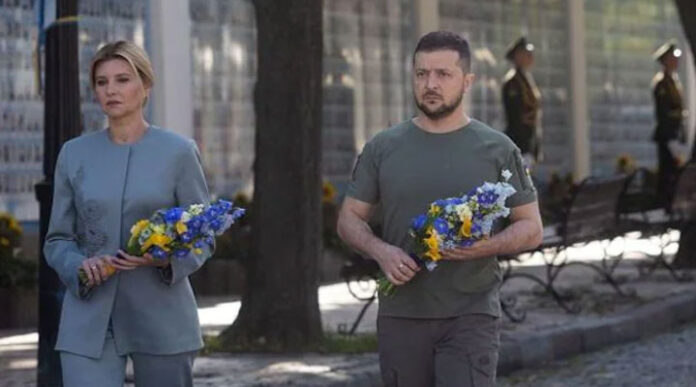The world narrowly avoided a nuclear disaster when electricity to Europe’s largest nuclear power plant was cut off for hours, according to Ukraine’s president, who urged international bodies to act quickly to force Russian troops to leave the site.
President Volodymyr Zelenskiy said on Thursday that Russian shelling had caused fires in the ash pits of a nearby coal power station, cutting the Zaporozhzhia plant off the power grid. According to a Russian official, Ukraine is to blame.
Back-up diesel generators ensured power supply for the plant’s cooling and safety systems, Zelenskiy said, praising the Ukrainian technicians who operate the plant under Russian military surveillance.
“If our station staff had not acted immediately after the blackout, we would have already been forced to deal with the consequences of a radiation accident,” he said in a video address Thursday evening.
“Russia has placed Ukraine and all Europeans on the verge of a nuclear disaster… Every minute that Russian troops remain at the nuclear power plant increases the risk of a global radiation disaster “He stated.
Residents in Kyiv, 556 kilometers (345 miles) to the northwest of the plant, expressed concern about the situation.
“Of course, everyone is terrified; the entire world is afraid. I desperately want the situation to get better. “Volodymyr, a 35-year-old businessman who declined to give his last name, said. “I want power shortages to be resolved and new facilities to be operational.”
According to Ukraine’s state nuclear company Energoatom, electricity for the plant’s own needs is now supplied via a power line from Ukraine’s electricity system. It later announced that one of the plant’s two operational reactors had been reconnected to the grid.
Vladimir Rogov, a Russian-appointed official in the occupied town of Enerhodar near the plant, blamed Ukrainian armed forces for the incident on Thursday, claiming they started a fire in a forest near the plant.
“As a result of Zelenskiy’s fighters’ provocations, power lines from the Zaporizhzhia nuclear power station were disconnected,” Rogov wrote on Telegram. “The disconnection was caused by a fire and a short circuit on the power lines.”
The Russian Defense Ministry said on Friday that its forces had destroyed a US-made M777 howitzer that Ukraine had used to shell the Zaporizhzhia plant. Satellite images showed a fire near the plant, but the cause could not be determined.
HOTSPOT
Energoatom said Thursday’s incident was the first complete disconnection of the plant, which has become a hotspot in the six-month-old war.
The regional authorities in Zaporizhzhia said more than 18,000 people remained without power on Friday due to damage to power lines, but did not specify which lines.
On Friday, a Reuters cameraman reported that electricity was working normally in the city of Zaporizhzhia.
Russia invaded Ukraine in February, captured the plant in March, and has controlled it ever since, though Ukrainian workers continue to operate it. Russia and Ukraine have accused each other of shelling the site, fueling fears of a nuclear disaster.
The UN is attempting to gain access to the plant and has requested that the area be demilitarised. Officials from the International Atomic Energy Agency (IAEA) are “very, very close” to visiting Zaporizhzhia, said IAEA Director-General Rafael Grossi on Thursday.
Germany condemned Russia’s continued occupation of the plant on Friday. “The situation (there) remains extremely dangerous,” a foreign ministry spokesman said.
Nuclear experts have expressed concern about the possibility of damage to the plant’s spent nuclear fuel pools or reactors. Power cuts required to cool the pools could result in a disastrous meltdown.
According to Paul Bracken, a national security expert and professor at the Yale School of Management, the concern is that artillery shells or missiles could puncture the reactor walls and spread radiation far and wide, similar to the Chornobyl reactor accident in 1986.
A failure at the Zaporizhzhia plant could “kill hundreds or thousands of people and harm the environment in a much larger area stretching all the way into Europe,” according to Bracken.
“Russian Roulette is a good metaphor because the Russians are spinning the revolver chamber and threatening to blow out the brains of the reactors all over Europe,” he explained.
FIGHTING
Russia’s ground campaign has stalled in recent months after its troops were driven out of Kyiv in the early days of the invasion, but fighting continues to the south and east.
Russian forces control territory along Ukraine’s Black Sea and Sea of Azov coasts, while the conflict in the eastern Donbas region, which includes the provinces of Donetsk and Luhansk, has devolved into a war of attrition.
Explosions were heard early Friday in Mykolaiv, Ukraine’s southernmost city, a key battleground as Russian forces try to push further west along the coast, cutting Ukraine off from the Black Sea.
The immediate cause of the explosions was unknown, according to regional governor Vitaliy Kim, who added that two villages nearby had been shelled. There were no casualties reported.
The Ukrainian military said it had repulsed Russian assaults on the towns of Bakhmut and Soledar in the eastern Donetsk region, as well as ammunition depots and enemy personnel in the southern Kherson region.
Ukrainian forces fired 10 rockets from a HIMARS multiple rocket launcher supplied by the United States at the town of Stakhanov in the eastern Donbas region, pro-Moscow breakaway officials in Luhansk were quoted as saying by Russia’s TASS news agency.
Reuters was unable to confirm either side’s battlefield reports.
The Kremlin claims that its goal is to “denazify” and demilitarise Ukraine in order to eliminate perceived security threats to Russia. Ukraine and the West argue that this is a sham pretext for a conquest war.





